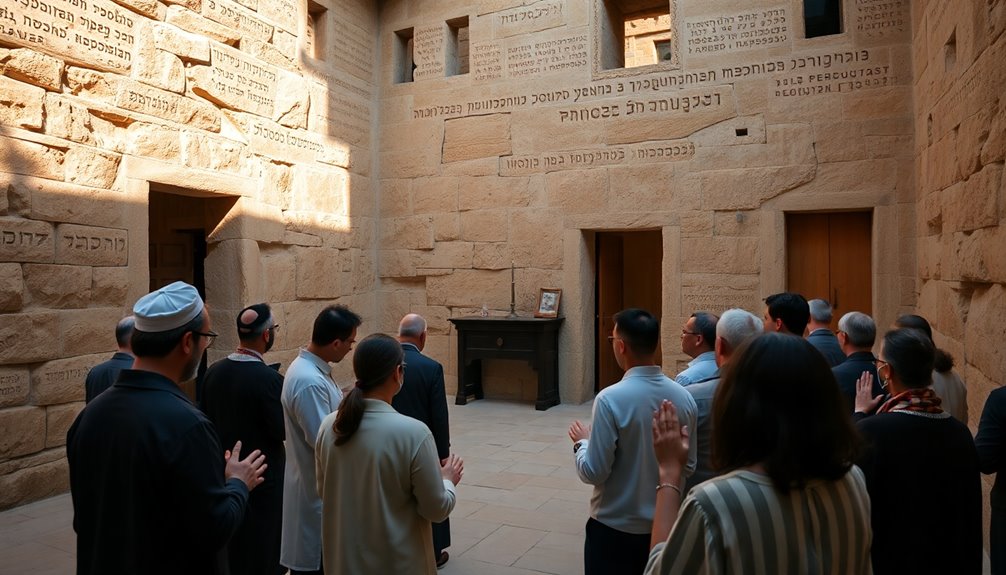There are several types of prayer that can deepen your relationship with God. You might engage in adoration, expressing love and reverence, or lament, which allows you to voice your struggles and grief. Intercession is another type where you pray for others. Thanksgiving centers on expressing gratitude for God's blessings. Each form serves a unique purpose and can enhance your spiritual journey. Exploring these types will help you understand their significance and how they fit into your daily life. There's so much more to discover about each type and how they can transform your practice.
Key Takeaways
- Adoration involves expressing love and reverence for God, acknowledging His greatness and holiness (Psalm 99:5).
- Lament is a form of prayer that articulates sorrow and grief, seeking comfort and understanding in times of distress (Psalm 88:1-7).
- Thanksgiving focuses on expressing gratitude for God's blessings and provisions, fostering a positive mindset (Daniel 2:20-23).
- Intercession is pleading on behalf of others, asking for God's mercy and intervention in their lives (Exodus 32:11-14).
- Confession involves acknowledging and repenting of sins, seeking forgiveness and restoration in the relationship with God (Psalm 51).
Introduction

Prayer is a powerful practice that takes many forms, each with its own purpose and significance. You might find that understanding these variations can deepen your spiritual connection with God. Among these types, thanksgiving stands out as a vital expression of gratitude. When you take time in prayer to reflect on God's blessings, you acknowledge His presence and goodness in your life.
Thanksgiving isn't just a routine; it's an intentional act that cultivates a heart of appreciation. By recognizing the gifts you've received, you foster a positive mindset and strengthen your faith. This form of prayer contrasts with others, like intercession, where you pray on behalf of others, or confession, where you admit your shortcomings and seek forgiveness.
As you explore different types of prayer—adoration, lament, supplication—each serves to enrich your dialogue with God. They offer unique opportunities to express your thoughts and feelings, whether you're celebrating His greatness or sharing your struggles.
Embracing these diverse aspects of prayer can transform your spiritual life, allowing you to connect with God on a deeper level and experience His love in various ways. Additionally, incorporating continuous learning and adaptation into your prayer practice can enhance your spiritual growth and understanding.
Biblical Prayer Examples

When you look at biblical examples of prayer, you'll find various forms that reflect different aspects of your relationship with God.
From adoration in Psalm 99:5 to confession in Psalm 51, these prayers offer insights into how you can communicate with Him.
Let's explore both primary and secondary Bible references that highlight these diverse types of prayer.
Primary Bible References
Exploring the types of prayer reveals rich examples throughout the Bible that illustrate various forms of communication with God. Each of these examples can enrich your prayer life.
For instance, adoration is beautifully captured in Psalm 99:5, where you honor God's holiness, and Psalm 104:1-4, which showcases His greatness in creation through a prayer of praise.
When you feel sorrowful, the lament expressed in Psalm 88:1-7 and Lamentations 5:1-5 shows that it's okay to voice your struggles and pain to God.
Thanksgiving is equally crucial; you can thank God for His wisdom and providence, as Daniel did in Daniel 2:20-23.
Intercession plays a significant role, too, as seen in Exodus 32:11-14, where Moses pleads for the Israelites, underlining the importance of praying on behalf of others.
Lastly, confession is vital in your prayer life. Psalm 51 exemplifies repentance, emphasizing the need to acknowledge sin and seek God's forgiveness.
Each of these primary Bible references guides you in embracing diverse forms of prayer, enhancing your spiritual connection with God.
Secondary Bible References
Throughout Scripture, you'll find powerful examples of prayer that demonstrate its various forms and purposes. One striking instance is in Psalm 99:5, where the psalmist calls to "exalt the Lord our God and worship at his footstool; he's holy." This highlights the essence of adoration, inviting you to praise God's inherent qualities.
In contrast, Psalm 88:1-7 reveals lament, as the psalmist expresses deep anguish and cries out to God in distress. It reminds you that sharing your struggles is an essential part of prayer.
Thanksgiving is beautifully illustrated in Daniel 2:20-23, where Daniel acknowledges God's wisdom, stating, "I thank and praise you, God of my ancestors." This emphasizes the importance of gratitude in recognizing God's sovereignty.
Additionally, Exodus 32:11-14 showcases intercession, as Moses pleads with God on behalf of the Israelites, demonstrating the power of praying for others' needs.
Lastly, Psalm 51 serves as a profound example of confession, where David seeks God's mercy, reminding you of the necessity of acknowledging sin and asking for forgiveness.
These examples enrich your understanding of prayer's multifaceted nature.
Ancient Jewish Prayer Practices

Ancient Jewish prayer practices reflect a rich tapestry of communal and personal expressions of faith, deeply rooted in tradition. You'll find that these practices often emphasize both individual and collective worship.
The Shema, recited daily, affirms your faith in God and serves as a cornerstone of Jewish identity. Another central part of Jewish liturgy is the Amidah, or Standing Prayer, which consists of 19 blessings that cover various types of prayers, including petitions and confessions.
When you engage in prayer, you might express gratitude through a prayer of thanksgiving or seek forgiveness by saying, "I confess my transgressions." This variety allows for a comprehensive dialogue with God.
Additionally, the Psalms play a crucial role in these ancient practices, often recited during synagogue services as expressions of worship, lament, and thanksgiving.
You may also notice the tradition of wearing tefillin during prayer, reinforcing the connection to God's commandments.
Together, these elements highlight how ancient Jewish prayer practices create a meaningful framework for communicating with the Divine, enriching both personal and communal experiences of faith.
Cultural Significance of Prayer

Prayer holds deep cultural significance across various societies, serving not just as a form of communication with the divine but also as a vital expression of community and identity. It's a universal practice that embodies communal values, fostering belonging among participants.
In many cultures, prayer rituals mark important life events like births, weddings, and funerals, providing comfort during transitions for individuals and families.
The psychological benefits of prayer are notable too. Studies show that engaging in prayer can reduce anxiety and enhance feelings of connectedness, which contributes to overall mental well-being within cultural contexts.
Different prayer styles, whether silent meditation, vocal prayers, or ritualistic movements, reflect the unique beliefs and values of various communities, showcasing their cultural significance.
Moreover, prayer's presence in public and political life highlights its role in shaping cultural identities and moral frameworks. From religious gatherings to national events, prayer connects people, reinforcing their relationship with God and each other.
In these ways, prayer transcends mere practice, becoming a cornerstone of cultural expression and shared identity.
Prayer as a Ritual Practice

Many people misunderstand prayer as merely a personal request or a moment of silence.
In reality, ritual prayer serves a deeper purpose, connecting you with a community and enhancing your spiritual focus.
Debunk Common Misconceptions
Understanding prayer as a relational communication with God can help dispel the misconception that it's just a ritualistic practice. Many people think prayer is all about following specific formulas or reciting set phrases, but it's so much more than that. God desires a genuine connection with you, where your thoughts and feelings flow freely.
While rituals can provide structure, they shouldn't define your entire prayer life. If you believe that particular words or gestures are required to gain God's attention, you might miss the heart of the matter. The effectiveness of prayer hinges not on its structure but on the sincerity of your heart. Remember Jesus' critique of empty prayers in Matthew 6:5-6; it's about authenticity.
Prayer should be spontaneous and heartfelt, fostering intimacy and spiritual growth. When you view prayer as a dynamic interaction rather than a duty, you'll find it transforms into a beautiful dialogue.
Embrace the idea that God wants to hear your voice, your concerns, and your gratitude. By doing so, you'll discover that your conversations with Him can lead to good things, enriching your spiritual journey far beyond mere rituals.
Misunderstanding Prayer's Purpose
Rituals can easily overshadow the true essence of prayer, leading people to see it as a mere checklist rather than a meaningful conversation with God. When you approach prayer as just a routine, you risk reciting words without genuine engagement or emotional connection.
This mechanical approach can diminish the transformative power of prayer, which is meant to foster spiritual growth, healing, and guidance. God wants us to communicate with Him authentically, as emphasized in the Bible.
Philippians 4:6 encourages you to approach God with heartfelt requests, reminding you that prayer is fundamentally about building a relationship. For followers of God, prayer should be an intimate dialogue where you share your thoughts, fears, and gratitude.
Even community prayer, often viewed as a ritual, should be a collective expression of faith. It amplifies the voices and petitions of believers and reinforces your reliance on God's will and timing.
Daily Prayer Routines

Establishing a daily prayer routine can transform your spiritual life, and incorporating journaling can help you track your thoughts and intentions.
You might also find that participating in group prayer initiatives enhances your experience and connects you with others.
Let's explore how these practices can strengthen your faith and community ties.
Daily Prayer Journaling Tips
How can you make daily prayer journaling a meaningful part of your spiritual routine? Start by setting a consistent time for journaling each day. This helps establish a habit that deepens your connection with God.
Begin each entry by giving thanks; list at least three things you're grateful for. This practice cultivates a positive mindset and appreciation for your blessings.
Next, incorporate Scripture into your journaling. Write down a verse or passage that speaks to you during your prayer time. Reflecting on its meaning can provide insight and guidance for your life.
Don't forget to record prayer requests and answers. Jot down specific requests and later note how they're answered. This can strengthen your faith and awareness of God's work in your life.
Finally, dedicate space in your journal for personal growth reflections. Note areas where you've grown, challenges you've faced, and how prayer has influenced your journey.
Group Prayer Initiatives
Group prayer initiatives can profoundly enrich your spiritual journey and strengthen community ties. By participating in these initiatives, you can experience the power of collective prayer and feel a strong sense of belonging. Many churches and faith organizations offer structured environments for daily prayer routines, including prayer meetings or prayer chains.
In these settings, you'll engage in different types of prayers, such as intercession, thanksgiving, and supplication. Each type brings its unique focus, allowing you to express your faith in various ways while asking God for guidance, support, and blessings. Regular participation in group prayer not only deepens your connection with others but also enhances your own spiritual growth.
Research shows that group prayer can boost your mental and emotional well-being, fostering feelings of connection and shared purpose. Moreover, being part of a group encourages accountability, helping you develop a disciplined prayer life. This makes it easier to incorporate prayer into your daily activities and relationships.
Prayer's Transformative Power

Through prayer, you tap into a profound source of transformative power that can reshape your circumstances and spirit. When you pray, you open a channel for divine intervention, inviting miraculous changes into your life. Engaging in various forms of prayer—like intercession, supplication, and thanksgiving—deepens your relationship with God our Savior and fosters spiritual growth.
Collective prayer amplifies individual voices, creating unity within your community and enhancing shared experiences. This connection not only strengthens your faith but also nurtures emotional healing and restoration, allowing you to process struggles and find comfort in God's presence.
As you consistently pray, you build resilience, equipping yourself to navigate life's challenges with hope and trust in God's promises. You discover that prayer isn't just about asking for help; it's a transformative practice that reshapes your mindset, helping you view challenges as opportunities for growth.
The more you engage in prayer, the more you realize its power to change not just your circumstances, but also your heart. Embrace this transformative journey, and let your prayers guide you closer to the divine.
Additional Resources

Exploring different types of prayer can deepen your spiritual journey and enhance your prayer life. To support this endeavor, consider utilizing various resources that can enrich your understanding and practice.
Prayer journals, for instance, are powerful tools. They help you track your prayers, reflect on answered requests, and foster a more intentional prayer routine.
Engaging in community prayer groups can also be incredibly beneficial. These groups offer a space for support, accountability, and shared experiences. You'll find that discussing different prayer types with others can broaden your perspective and inspire new practices.
Additionally, workshops and retreats focused on prayer provide immersive experiences that can transform your approach. These settings teach effective methods and allow you to practice in a guided environment, enhancing both your skills and your connection to the divine.
Finally, don't overlook online resources. Many platforms offer guided prayers and meditation exercises tailored to various styles and preferences. By exploring these resources, you'll not only deepen your prayer life but also cultivate a more profound spiritual connection.
Frequently Asked Questions
What Are the 4 Main Types of Prayer?
When you think about prayer, you might realize it can take on different forms.
First, there's adoration, where you praise God for His greatness.
Then, you might find yourself confessing, acknowledging your shortcomings and seeking forgiveness.
Thanksgiving comes next, as you express gratitude for His blessings in your life.
Finally, you'll often engage in supplication, asking God for help and guidance in your personal or communal needs.
Each type deepens your relationship with Him.
What Are the Seven Prayers in the Bible?
When you look at the Bible, you'll find seven distinct prayers that guide your relationship with God.
These include adoration, where you praise His holiness; confession, acknowledging your sins; thanksgiving, expressing gratitude for His blessings; and supplication, making earnest requests for your needs.
Additionally, there's intercession, where you pray for others, deliverance, seeking freedom from burdens, and guidance, asking for direction in your life.
Each prayer serves a unique purpose in your spiritual journey.
What Are the Five Main Prayers?
When you think about the five main prayers, consider how each serves a unique purpose in your spiritual journey.
You might express adoration for God's greatness, admit your wrongdoings in confession, and show gratitude during thanksgiving.
Then, you can request specific needs through supplication and pray for others in intercession.
Each form strengthens your relationship with God and helps you understand His will in your life.
Embrace these practices for deeper connection.
What Are the 4 Types of Prayer in 1 Timothy?
In 1 Timothy 2:1, you'll find four key types of prayer.
First, there's supplication, where you earnestly ask for your needs and those of others.
Then, you engage in general prayers, fostering continuous dialogue with God.
Intercession follows, encouraging you to pray on behalf of others, especially leaders.
Lastly, don't forget thanksgiving, as expressing gratitude is essential in your prayer life.
Together, these elements create a holistic approach to connecting with God.










